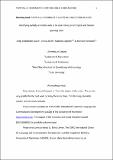Files in this item
Identifying partially schematic units in the code-mixing of an English and German speaking child
Item metadata
| dc.contributor.author | Endesfelder Quick, Antje | |
| dc.contributor.author | Lieven, Elena | |
| dc.contributor.author | Carpenter, Malinda | |
| dc.contributor.author | Tomasello, Michael | |
| dc.date.accessioned | 2017-04-06T10:30:08Z | |
| dc.date.available | 2017-04-06T10:30:08Z | |
| dc.date.issued | 2017-03-07 | |
| dc.identifier | 249000612 | |
| dc.identifier | abe58ab3-91d0-4b7a-a96a-68bb8752d84b | |
| dc.identifier | 85052647515 | |
| dc.identifier | 000443326000003 | |
| dc.identifier.citation | Endesfelder Quick , A , Lieven , E , Carpenter , M & Tomasello , M 2017 , ' Identifying partially schematic units in the code-mixing of an English and German speaking child ' , Linguistic Approaches to Bilingualism , vol. 8 , no. 4 , pp. 477-501 . https://doi.org/10.1075/lab.15049.qui | en |
| dc.identifier.other | ORCID: /0000-0003-3983-2034/work/64698007 | |
| dc.identifier.uri | https://hdl.handle.net/10023/10590 | |
| dc.description | The support of the Economic and Social Research Council [ES/L008955/1] is gratefully acknowledged. | en |
| dc.description.abstract | Intra-sentential code-mixing presents a number of puzzles for theories of bilingualism. In this paper, we examine the code-mixed English-German utterances of a young English-German-Spanish trilingual child between 1;10 – 3;1, using both an extensive diary kept by the mother and audio recordings. We address the interplay between lexical and syntactic aspects of language use outlined in the usage-based approach (e.g. Tomasello, 2003). The data suggest that partially schematic constructions play an important role in the code-mixing of this child. In addition, we find, first, that the code-mixing was not mainly the result of lexical gaps. Second, there was more mixing of German function words than content words. Third, code-mixed utterances often consisted of the use of a partially schematic construction with the open slot filled by material from the other language. These results raise a number of important issues for all theoretical approaches to code mixing, which we discuss. | |
| dc.format.extent | 712739 | |
| dc.language.iso | eng | |
| dc.relation.ispartof | Linguistic Approaches to Bilingualism | en |
| dc.subject | Code-mixing | en |
| dc.subject | Usage-based | en |
| dc.subject | Bilingual child | en |
| dc.subject | English - German | en |
| dc.subject | Partially schematic constructions | en |
| dc.subject | BF Psychology | en |
| dc.subject | NDAS | en |
| dc.subject.lcc | BF | en |
| dc.title | Identifying partially schematic units in the code-mixing of an English and German speaking child | en |
| dc.type | Journal article | en |
| dc.contributor.institution | University of St Andrews. School of Psychology and Neuroscience | en |
| dc.contributor.institution | University of St Andrews. Centre for Social Learning & Cognitive Evolution | en |
| dc.identifier.doi | 10.1075/lab.15049.qui | |
| dc.description.status | Peer reviewed | en |
This item appears in the following Collection(s)
Items in the St Andrews Research Repository are protected by copyright, with all rights reserved, unless otherwise indicated.

